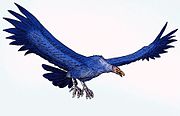Megafauna
From Wikipedia, the free encyclopedia
The term megafauna (Ancient Greek megas "large" + New Latin fauna "animal") has two distinct meanings in the biological sciences. The less commonly found meaning is of any animal which can be seen with the unaided eye, in contrast to microfauna. The more commonly found meaning, discussed in this article, is of "giant", "very large" or "large" animals — although there is no standard definition of a minimum size.
In practice the most common usage encountered in academic and popular writing describes land animals roughly larger than a human which are not (solely) domesticated. The term is especially associated with the Pleistocene megafauna — the giant and very large land animals considered archetypical of the last ice age such as mammoths.[1] It is also commonly used for the largest wild land animals surviving today, especially elephants, giraffes, hippopotamuses, rhinoceroses, moose, condors, etc.
Other common uses are for giant aquatic species, especially whales, any larger wild or domesticated land animals such as larger antelope and cattle, and dinosaurs and other extinct giant reptilians.
Some technical definitions of size however go down to as small as 40-45kg (90 lbs)[2][3] and thus encompass a great many animals commonly regarded as not especially large, such as goats and (larger) domestic dogs.
The term is also sometimes applied to animals (usually extinct) of great size relative to a more common or surviving type of the animal, for example the 1m (3 ft) dragonflies of the Carboniferous age.
[edit] Ecological Strategy of Megafauna
Megafauna — in the sense of the largest mammals and birds — are generally K-strategists, with great longevity, slow population growth rates, low death rates, and few or no natural predators capable of killing adults. These characteristics, although not exclusive to such megafauna, make them highly vulnerable to human over-exploitation.
[edit] Megafauna Mass Extinctions
The two most well-known mass extinctions of megafauna are the Cretaceous–Tertiary extinction event in which the dinosaurs and most other giant reptilians were wiped out, and the Pleistocene-Holocene extinction event at the end of the last ice age in which the giant ice age animals such as mammoths were wiped out.
[edit] Examples of megafauna
[edit] Pre-Pleistocene Megafauna
[edit] Temperate Forest Megafauna
|
|
[edit] Coniferous Forest Megafauna
|

Kodiak Bears are very large predators, full grown males can weigh as much as 477-534 kg (1,051-1,177 lb).
|
[edit] Tropical Forest Megafauna
|
|
[edit] Highland Megafauna
|
|
[edit] Desert Megafauna
|

All Dromedary Camels have been domesticated, yet some still roam feral in Australia.
|
[edit] Grassland Megafauna
|
|
[edit] Freshwater Megafauna
|
|
[edit] Marine Megafauna
|
|
[edit] Polar Megafauna
|
|
[edit] Domestic and Urban Megafauna
|

Certain breeds of rabbit have been bred to be very large. Certain breeds, like the Flemish Giant and German Gray can get to be over 10 kg (23 lb).
|
[edit] Hybrid Megafauna

Strangely, the Liger can get heavier than any Siberian Tiger, the largest at 408.25 kg (900 lb).
|
[edit] See also
- Bergmann's Rule
- Cope's rule
- Deep-sea gigantism
- Fauna
- Island dwarfism
- Island gigantism
- Largest organisms
- List of megafauna discovered in modern times
- List of African megafauna
- List of Arctic megafauna
- List of Australian megafauna
- List of Central and South American megafauna
- List of Eurasian megafauna
- List of island megafauna
- List of marine megafauna
- List of North American megafauna
- New World Pleistocene extinctions
- Quaternary extinction event
[edit] References
- ^ Ice Age Animals, Illinois State Museum
- ^ Defense of the Earth. Past consequences of climate change: Evolutionary history of the mammals.
- ^ Corlett, R. T. (2006). Megafaunal extinctions in tropical Asia. Tropinet 17 (3): 1–3.









